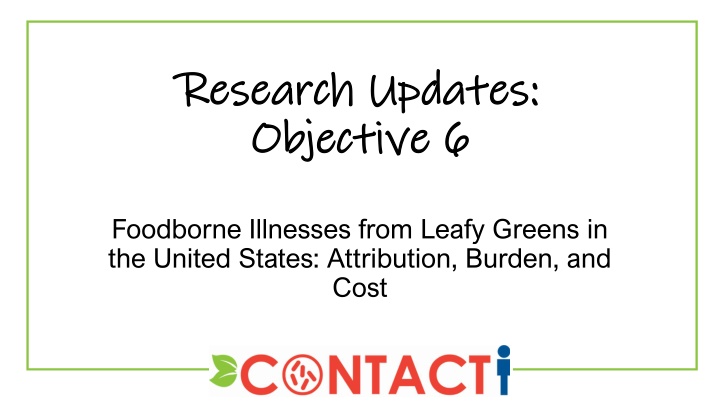
Leafy Greens-Related Foodborne Illnesses in the United States
Research findings reveal that Norovirus, Campylobacter, and STEC are major pathogens causing foodborne illnesses linked to leafy greens, with annual estimated occurrences of 2,307,558 cases and economic costs amounting to $5.28 billion. Lettuce varieties, particularly romaine and iceberg, are identified as the primary culprits. These insights shed light on the attribution, burden, and costs associated with leafy greens in the US.
Uploaded on | 1 Views
Download Presentation

Please find below an Image/Link to download the presentation.
The content on the website is provided AS IS for your information and personal use only. It may not be sold, licensed, or shared on other websites without obtaining consent from the author. If you encounter any issues during the download, it is possible that the publisher has removed the file from their server.
You are allowed to download the files provided on this website for personal or commercial use, subject to the condition that they are used lawfully. All files are the property of their respective owners.
The content on the website is provided AS IS for your information and personal use only. It may not be sold, licensed, or shared on other websites without obtaining consent from the author.
E N D
Presentation Transcript
Research Updates: Research Updates: Objective 6 Objective 6 Foodborne Illnesses from Leafy Greens in the United States: Attribution, Burden, and Cost
Research Highlights Research Highlights Leafy greens illness attribution rate is highest for Shiga toxin- producing E. coli. Norovirus, STEC, Campylobacter have highest leafy green illnesses and cost. Lettuces linked to over 75.7% of leafy green foodborne illnesses and 70% costs. Up to 9.2% of known pathogen-caused foodborne illnesses attributed to leafy greens. Leafy greens tied to 2,307,558 estimated illnesses and $5.28 billion cost annually.
Leafy Green Attribution, Annual Illnesses, and Leafy Green Attribution, Annual Illnesses, and Annual Economic Costs in the United States Annual Economic Costs in the United States Norovirus leads in leafy green-associated illnesses, followed by STEC Non-O157, and Campylobacter spp.
Leafy Green Attribution, Annual Illnesses, and Leafy Green Attribution, Annual Illnesses, and Annual Economic Costs in the United States Annual Economic Costs in the United States Norovirus, Campylobacter spp., STEC O157:H7, and Salmonella (nontyphoidal) represent the largest economic costs from contaminated leafy greens.
The Number of Illnesses Caused The Number of Illnesses Caused by All Pathogens Attributed to by All Pathogens Attributed to Leafy Greens per Year Leafy Greens per Year The lettuce family, including romaine, iceberg, and other lettuce , are associated with the majority of leafy green-related foodborne illnesses, ranging from 58.8% to 75.7% across models M1 (a simple food outbreak model) and M2 (the simple and complex food outbreak model).
The Number of Illnesses Caused The Number of Illnesses Caused by All Pathogens Attributed to by All Pathogens Attributed to Leafy Greens per Year Leafy Greens per Year Leafy greens are responsible for up to 9.18% of all known pathogen-caused foodborne illnesses, or 2,307,558 illnesses annually. This leads to health- related costs of up to $5.278 billion.
More Information More Information Check out Check out our paper! our paper! Robert Scharff Robert Scharff Professor of Human Sciences The Ohio State University scharff.8@osu.edu Xuerui Xuerui Yang Yang Graduate Research Associate The Ohio State University yang.6121@osu.edu This work is supported by the Specialty Crops Research Initiative [grant no. 2020-51181-32157] from the USDA National Institute of Food and Agriculture. Any opinions, findings, conclusions, or recommendations expressed in this presentation are those of the speakers and do not necessarily reflect the view of the U.S. Department of Agriculture.









